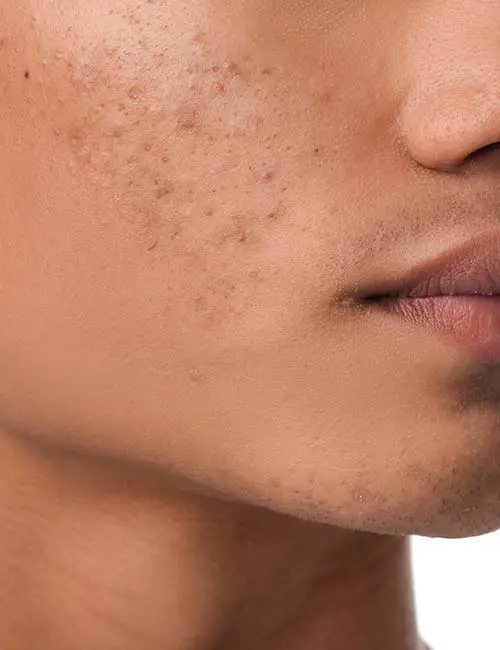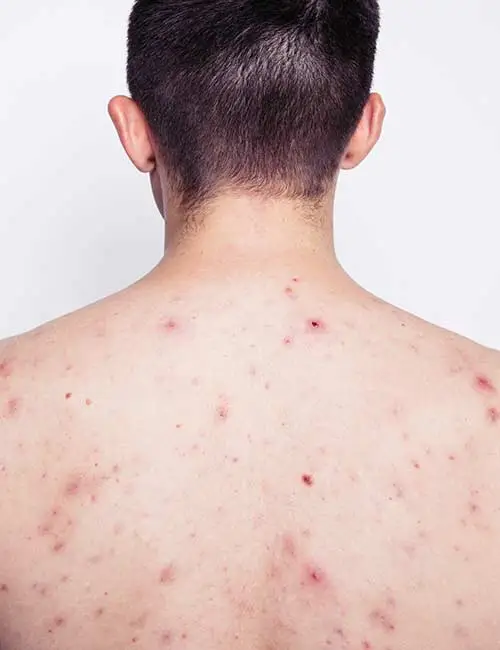Acne
Acne affects in varying degree, nine out of ten people at some time during adolescence. However, it is not only a disease of adolescence. It may affect newborn infants, and not infrequently, women in the 20’s, 30’s, or 40’s.
Clinical features
Acne involves those areas of the skin where oil glands are most prominent, that is, the face, neck, chest, shoulders and back. The lesions may range from a non-inflamed blackhead or whitehead, to inflamed pustules, to deep boil-like lesions. It is these latter inflammatory lesions that scar.
What causes acne
The chain of events resulting in the development of acne begins beneath the skin’s surface in the hair follicles and their attached oil glands. Two changes occur at this site: Over-activity of the oil glands. At puberty, the oil glands in the skin increase in size, and increase the output of their oily secretion called sebum. This increase is directly stimulated by certain body hormones “androgens” which are normally produced in greater quantity in both boys and girls during adolescence. It does not necessarily mean that there is a hormone abnormality.
Obstruction of the follicle. Like the skin’s surface, the follicle walls normally produce cells. These are loose and end up being carried to the surface and shed. But for some reason, perhaps genetic, the follicles of the acne-prone individual produce cells that are “sticky” and plug up the follicle opening. With no outlet for sebum and the dead cells, non-inflamed comedones (whiteheads and blackheads) form. Certain skin bacteria that normally live within the follicle contain enzymes that convert the trapped sebum into irritant fatty acids. If the wall of the plugged follicle breaks down, the sebum and fatty acids, and bacteria escape into the surrounding skin causing inflammation. This produces the classic inflamed acne pustules and boil-like cysts.
Myths to be dispelled
Acne is not caused by dirt. No matter how hard you scrub, you cannot scrub away acne because it develops under the surface of the skin. Foods do not cause acne. The role of diet in acne production has been over-emphasized in the past. But nevertheless, in some people, certain foods do seem to aggravate or make acne worse. The most common ones are greasy or fatty foods such as nuts, butter, fatty meats, and certain cheeses; and sweets such as chocolates and cola drinks. It is best to have a healthful, well-balanced diet and avoid any foods that you feel aggravate your acne. Avoid seaweed and kelp pills.
Acne is not caused by nerves and worry, but again, in some people, stress such as school examinations or pressure at work may cause mild temporary flare-ups or worsening of the acne. Adequate rest, a healthful diet, and regular outdoor exercise helps.
Treatments
Although there is yet no instant cure, much can be done to help the person who has acne. Your acne can, and will improve with treatment. In some cases, improvement may be slow but this should not be a cause for discouragement or neglect. You must understand that treatment of acne is a continuing process if it is to be controlled successfully. Treatment takes time. It takes four to six weeks before the response to any treatment regimen can be assessed. You must follow the instructions of your physician, since you are the only one who can accomplish the necessary daily care. Treatment must be determined on an individual basis. The course of treatment selected by the physician will vary according to such factors as type of acne, its severity and its extent. Some medications work better than others in certain cases; and the physician’s advice and prescription is based on these differences. In general, however, the treatment of acne is directed at the three targets in the chain of events producing the lesions:
- Decrease follicle ductal obstruction. Vitamin A acid, also called retinoic acid, is applied to the skin. This acts primarily by helping the follicles to produce cells that are less sticky; so that they can be shed at the surface as is normally the case, rather than obstructing the follicle opening.
- Decrease the number of bacteria. Antibiotics, which may be applied directly to the skin and/or taken internally, act to reduce populations of specific skin bacteria. Benzoyl peroxide preparations, when applied to the skin, act almost like an antibiotic to sterilize the follicle, as well as tending to dry up surface oil and cause superficial peeling.
- Reduce sebum production. Accutane, a drug taken internally, inhibits sebum production. This potentially toxic drug is limited only to patients with severe nodulocystic scarring facial acne, whose condition has not responded to other accepted therapeutic regimens.
In conclusion, remember that acne improves slowly; but irrespective of the severity, modern dermatologic treatment is helpful in nearly every case.
Cryotherapy
This therapy for acne uses a very cold medication (liquid nitrogen) to gently exfoliate the skin. It is especially beneficial to the blackheads and white heads. It will help to make the acne respond faster. In some patients, it will help the tender red bumps. Most insurance’s consider this a surgical procedure. The procedure will not normally cause redness. The skin that is removed is very fine.
Acne Surgery
This is a procedure used to remove resistant white heads and black heads. A special instrument is used to extract the clogged pore. Occasionally closed pores need to be opened with a fine blade to allow an opening for the clog to be removed. This procedure will usually cause redness for the day of the procedure. This is considered a surgical procedure.
Injections of CYSTS
This is a therapy used for isolated inflamed cysts. A steroid medication is injected directly into a tender lesion to rapidly remove it. This is a surgical procedure. It is not used routinely. The acne lesion will normally resolve within 24 hours. There may be a light spot or thin area that remains in the treated area. If the acne lesion is infected it can also make the lesion get bigger.
Chemical Exfoliation/Superficial Peels
This is an optional therapy that will speed the improvement of most acne skin lesions. This is an in office procedure provided by our aesthetician. A series of six Glycolic peels are used on the skin to aggressively exfoliate the skin to remove the clogged pores. It also benefits the tender red bumps, and discoloration. It also smoothes the skin and decreases fine wrinkles and sun damage. Normally after the procedure, you look refreshed. There is occasionally some redness. Most insurance companies now consider this a cosmetic procedure and will not allow this as covered service. If you would like to have this procedure, an appointment is made with our aesthetician to further explain the procedure. This can be used along with the acne medications.
Cosmetics for the Acne Patient
Foundations
Foundation makeup should be water-based. The following have been tested and are non-comedogenic or non-Acneogenic. (i.e. Do not cause blackheads or whiteheads):
- Almay Oil Control makeup.
- Estee Lauder Demi-Matte Oil Free makeup.
- Estee Lauder Enlighten Skin-Enhancing SPF 10 makeup.
- Clinique Pore Minimizer.
- Clinique Concealer Anti-Acne control formula (contains Salicyclic Acid).
- Lancombe Maquicontrol Oil-free makeup.
- Mary Kay Oil-free foundation.
Blushers and Eyeshadows
Avoid blushers and eyeshadows that contain these comedogenic agents: Isopropyl myristate and D & C red dyes. You may use:
- Almay cheek color and blushes.
- Clinique Beyond Blusher oil-free everywhere colour.
- Clinique eye shadows.
- Revlon eye shadows.
- Mary Kay.
Moisturizers
If a moisturizer is needed, it should be applied after cleansing and application of any topically prescribed product (ie. topical antibiotic or Benzoyl Peroxide). Please use one of the following:
- Neutrogen Facial Moisturizer with or without SPF 15.
- Almay Oil Control lotion with SPF-15.
- Avon Anew Perfecting lotion for problem skin.
- Mary Kay Oil Control Lotion.
Sunscreens
Use non-comedogenic and alcohol-based (not creamy) sunscreens such as:
- Presun lotion SPF 15 (in alcohol).
- Total Eclipse Number 15 (in alcohol).
- Mary Kay Sun Essentials products oil-free facial sunblock SPF-15.







